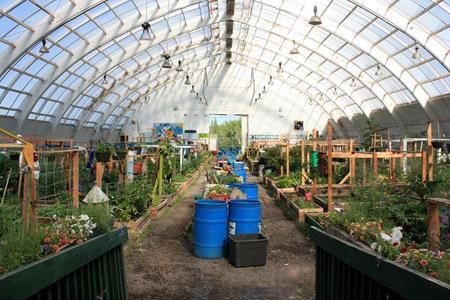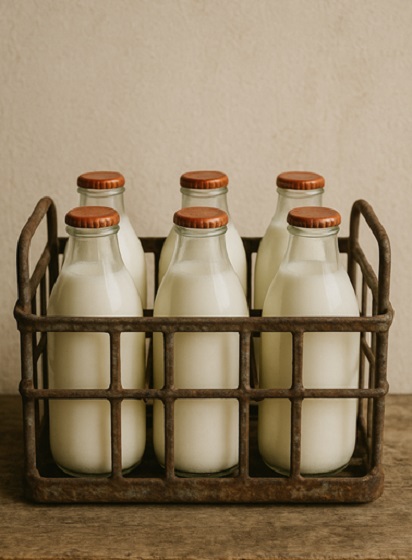Alberta
Greenhouses aim to bring fresh produce to North, putting a dent in food insecurity

INUVIK, N.W.T. — Rows upon rows of raised beds growing tomatoes, zucchini, beans, wildflowers and herbs line the inside of the Inuvik Community Greenhouse.
Sunlight streams through the panes of the curved ceiling above as children sprinkle their crop with green plastic watering cans.
The commercial greenhouse in the western Arctic community in the Northwest Territories is in a former hockey arena. There, community members can rent plots to grow vegetables and other plants, and learn about gardening.
“Every time I come in here, I only ever see people smiling,” said Adi Scott, who co-ordinates the greenhouse.
Remote and Indigenous communities, particularly in the North, are increasingly using greenhouses to grow their own produce, promote self-sufficiency and in some cases create economic opportunity, said Andrew Spring, an assistant professor at Wilfrid Laurier University and a Canada Research Chair in northern sustainable food systems.
“Food security has been an issue across the North because of the high cost of groceries … (and) the long-term impacts of colonization on northern Indigenous communities,” Spring said.
Data from Statistics Canada indicates that 46.1 per cent of people in Nunavut, 23.1 per cent in the Northwest Territories and 15.3 per cent in the Yukon lived in food-insecure households in 2019 compared with a national average of 10.6 per cent.
Much of the food flown North is processed, not to mention expensive, and access to fresh fruits or vegetables is limited, said Spring. Meanwhile, participation in traditional activities like gathering or hunting have been declining for decades in many communities, meaning they rely more on food from stores, he said.
Climate change “makes a vulnerable situation even more precarious,” said Spring, as it causes disruptions in air travel or on long-used ice roads.
Scott said the Inuvik greenhouse, which runs from April to September, can help put a dent in the grocery bill, but isn’t enough to truly reduce reliance on food from outside the territory. Instead, the greenhouse’s main focus is on education and community-building.
These days, it’s not difficult to get the funds to start up a greenhouse in a remote community, said Spring, with lots of federal programs available for agriculture and climate adaptation.
In December 2022, the federal government announced $19.5 million in support for up to 79 new projects across the country related to food security in Indigenous, remote and Northern communities as part of the fourth phase of the Local Food Infrastructure Fund. Since 2019, it has supported around 900 projects across the country, including greenhouses in remote and northern communities.
It’s important that organizations helping to start up greenhouse and other agriculture projects work with the community, said Raygan Solotki, executive director of Green Iglu. The non-profit helps remote communities plan, build and run projects, specializing in geodesic dome greenhouses.
“We’re not coming in on a horse, riding in with a greenhouse,” said Solotki. “We’re here to work with the community to make sure we are doing what the community wants.”
The biggest challenges often come once the greenhouse has been built, Spring said. Some communities have had more success than others building a sustainable long-term greenhouse or garden project, and it often revolves around having one person or a small group of people willing to commit to running it, he said.
“This community champion, who is passionate about it, and who has the kind of skills and the knowledge to do the work. And having those people stay in the community is often the challenge.”
Tom Henheffer, co-chief executive officer of the Arctic Research Foundation, also stressed the importance of building relationships with communities for projects to be successful.
The foundation partnered with Agriculture and Agri-Food Canada, National Research Council Canada, the Canadian Space Agency and the community of Gjoa Haven, Nvt., on the Naurvik project, a community-led hydroponic food system that started in 2019.
“A number of similar projects have failed and what differentiates this is really the people building it from the ground up with the community,” Henheffer said.
The work in the greenhouse is done by local technicians and its location was chosen by elders, Henheffer said. He added community members know best which vegetables local people want to eat to pair with foods like caribou stew and Arctic char.
Betty Kogvik, one of the technicians at the greenhouse, said it’s important for the community.
“The cost of food or produce we get from the store is really high … and when we finally receive them, some are already mouldy.”
Kogvik said high food costs are especially challenging for elders and people reliant on social assistance. She’s proud that everything grown at the greenhouse goes to elders and children.
The main food sources in the community are hunting and fishing, Kogvik said, and people share what they have harvested with friends and family.
Kogvik said she’d like to see the greenhouse project extended to other communities, adding it also provides employment opportunities.
The Naurvik project’s system is made from three retrofitted shipping containers and primarily uses wind and solar power year-round. Many northern communities are reliant on diesel, which can be costly and produce harmful emissions.
Conditions in Gjoa Haven, about 250 kilometres north of the Arctic Circle, make it difficult to grow vegetables. Access to fresh produce in the community is limited and expensive, Henheffer said, with vegetables nearing expiration by the time they reach shelves.
He said part of the project aims to replicate the system in other communities to increase access to fresh produce. The Canadian Space Agency is also interested in the technology to potentially grow food in space.
Hydroponics is a higher-tech way of indoor growing that doesn’t use soil, and is often used to grow herbs and leafy greens. Spring noted that in order to truly make a dent in food insecurity, northern growing projects need to be able to produce heartier vegetables that can be stored — “things that go in stew” as opposed to “salad.” Because of this, he said he’s wary of high-tech solutions like hydroponics.
But it all depends on what the community is looking for, he said, whether that’s a commercially viable greenhouse or a place to grow salad as an addition to the food available.
“Anything helps,” he said.
But the key to putting a dent in the food insecurity problem is “doing agriculture in a way that actually is the side dish to the traditional food system.”
This report by The Canadian Press was first published June 21, 2023.
— With files from Rosa Saba in Toronto
Emily Blake, The Canadian Press
Alberta
Poilievre poised for comeback in Alberta stronghold

This article supplied by Troy Media.
Byelection win in Battle River-Crowfoot looks inevitable for Poilievre
Conservative Party leader Pierre Poilievre unexpectedly lost his Ontario-based seat in the House of Commons in the federal election. He’s running in a byelection in a safe Conservative riding in a different province. While some of his opponents and critics are hoping that lightning will strike twice, they can safely put this pipe dream to rest.
Poilievre was first elected in 2004. He ran as a Conservative MP in the Nepean–Carleton riding against David Pratt, a two-term Liberal MP and then Minister of National Defence. It was predicted to be a close race, and that’s exactly what happened. The 25-year-old, who had previously been
involved in Reform Party and Canadian Alliance circles, worked hard in this riding. He established a strong ground game with new and existing grassroots support. He won the riding with 30,420 votes (45.7 per cent), while Pratt finished second with 26,684 votes (40.1 per cent).
The newly minted Conservative MP’s support in Nepean-Carleton expanded in the preceding elections. He won 54.7 per cent in 2006, followed by 55.84 per cent in 2008 and 54.45 per cent in 2011. When his old riding was recreated during the federal election redistribution in 2012, Poilievre shifted to the new riding of Carleton. It wasn’t quite as Conservative-leaning, which meant it would take more work to hang on to this seat.
The 2015 election was a tough battle for Poilievre, but he won 46.86 per cent versus Liberal candidate Chris Rodgers’s 43.74 per cent. He had an easier time against Rodgers in their 2019 rematch, winning 46.35 to 38.23 per cent. Poilievre nearly crossed the 50 per cent threshold in 2021, earning 49.9 per cent of the vote. He now seemed solidly entrenched in Carleton.
That’s what made Poilievre’s April 28 loss to lightly regarded Liberal candidate Bruce Fanjoy so surprising.
There were a few factors that likely contributed to this upset. The Ottawa region, where the Carleton riding is located, turned heavily against most Conservative candidates in this year’s election. Poilievre had to run a national campaign and couldn’t spend nearly as much time in his local riding as he had done in the past. The Longest Ballot Committee, which was established in 2021 to protest Canada’s first-past-the-post electoral system, flooded the ballot with independent candidates and muddied the political waters. And, as Fanjoy suggested in an April 29 interview with CBC Radio’s Ottawa Morning, the issue of U.S. President Donald Trump and his tariffs could have partially turned the tide.
So be it.
Poilievre wanted to continue in politics and remain Conservative leader. His next move was to find a new seat to run in a byelection. He needed to resolve this matter quickly so that he could return to the House of Commons.
When three-term Conservative MP Damien Kurek graciously decided to step aside from his seat in Battle River-Crowfoot on May 2, a unique opportunity had opened up. Would Prime Minister Mark Carney call a byelection? He told the media that “I will ensure that it happens as soon as possible… no games, nothing, straight.” To his credit, the PM kept his word. When Kurek officially resigned on June 17, Carney issued the byelection writ on June 30.
Battle River–Crowfoot is one of the safest Conservative ridings in Canada. There hasn’t been a close result since the rural Alberta riding was created in the aforementioned 2012 federal election redistribution. Kevin Sorenson won 80.91 per cent of the vote in 2015, while Kurek won 85.5 per cent, 71.3 per cent and 82.84 per cent in 2019, 2021 and 2025, respectively.
If you include results in other iterations of the riding—Acadia, Battle River, Battle River-Camrose, Camrose and Crowfoot—it’s been in the hands of a right-leaning politician for all but two years. The only time it changed was when former Progressive Conservative MP Jack Horner crossed the floor to the Liberals in 1977. He was then crushed in the 1979 election, earning only 18.2 per cent of the vote against Progressive Conservative candidate Arnold Malone’s 77.12 per cent. (Malone decisively beat Horner again in 1980, winning 76.61 to 15.53 per cent.)
Some political pundits and prognosticators may be hoping the Aug. 18 byelection will be closer than expected. Liberal candidate Darcy Spady, along with Independents Bonnie Critchley and Sarah Spanier and some smaller party candidates, are all attempting to beat Poilievre in a riding that he’s never represented. The independence movement that has encompassed Western Canada as of late goes right through this riding. The Longest Ballot Committee has targeted Battle River–Crowfoot in hopes of creating another Carleton-like upset, too. Don’t count on any of this happening, however.
338Canada, a respected Canadian-based political forecasting and commentary website, showed a massive Conservative lead of 80 per cent (with a possible uptick of up to six per cent) on July 13. The odds of a Conservative win in Battle River–Crowfoot are currently at 99 per cent.
Poilievre is firmly in the driver’s seat. While it obviously doesn’t matter what his margin of victory is in Battle River–Crowfoot, he would surely like to keep it close to Kurek’s most recent victory. This means he can’t rest on his laurels—which isn’t his style to begin with—and has to take it to the finish line.
That’s exactly what he’s going to do.
Michael Taube is a political commentator, Troy Media syndicated columnist and former speechwriter for Prime Minister Stephen Harper. He holds a master’s degree in comparative politics from the London School of Economics, lending academic rigour to his political insights.
Troy Media empowers Canadian community news outlets by providing independent, insightful analysis and commentary. Our mission is to support local media in helping Canadians stay informed and engaged by delivering reliable content that strengthens community connections and deepens understanding across the country.
Alberta
Upgrades at Port of Churchill spark ambitions for nation-building Arctic exports

In August 2024, a shipment of zinc concentrate departed from the Port of Churchill — marking the port’s first export of critical minerals in over two decades. Photo courtesy Arctic Gateway Group
From the Canadian Energy Centre
By Will Gibson
‘Churchill presents huge opportunities when it comes to mining, agriculture and energy’
When flooding in northern Manitoba washed out the rail line connecting the Town of Churchill to the rest of the country in May 2017, it cast serious questions about the future of the community of 900 people on the shores of Hudson Bay.
Eight years later, the provincial and federal governments have invested in Churchill as a crucial nation-building corridor opportunity to get resources from the Prairies to markets in Europe, Africa and South America.
Direct links to ocean and rail

Aerial view of the Hudson Bay Railway that connects to the Port of Churchill. Photo courtesy Arctic Gateway Group
The Port of Churchill is unique in North America.
Built in the 1920s for summer shipments of grain, it’s the continent’s only deepwater seaport with direct access to the Arctic Ocean and a direct link to the continental rail network, through the Hudson Bay Railway.
The port has four berths and is capable of handling large vessels. Having spent the past seven years upgrading both the rail line and the port, its owners are ready to expand shipping.
“After investing a lot to improve infrastructure that was neglected for decades, we see the possibilities and opportunities for commodities to come through Churchill whether that is critical minerals, grain, potash or energy,” said Chris Avery, CEO of the Arctic Gateway Group (AGG), a partnership of 29 First Nations and 12 remote northern Manitoba communities that owns the port and rail line.
“We are pleased to be in the conversation for these nation-building projects.”
In May, Canada’s Western premiers called for the Prime Minister’s full support for the development of an economic corridor connecting ports on the northwest coast and Hudson’s Bay, ultimately reaching Grays Bay, Nunavut.
Investments in Port of Churchill upgrades
AGG, which purchased the rail line and port from an American company in 2017, is not alone in the bullish view of Churchill’s future.
In February, Manitoba Premier Wab Kinew announced an investment of $36.4 million over two years in infrastructure projects at the port aimed at growing international trade.
“Churchill presents huge opportunities when it comes to mining, agriculture and energy,” Kinew said in a release.
“These new investments will build up Manitoba’s economic strength and open our province to new trading opportunities.”
In March, the federal government committed $175 million over five years to the project including $125 million to support the rail line and $50 million to develop the port.
“It’s important to point out that investing in Churchill was something that both the Liberal and Conservative parties agreed on during the federal election campaign,” said Avery, a British Columbian who worked in the airline industry for more than two decades before joining AGG.
Reduced travel time
The federal financial support helped AGG upgrade the rail line, repairing the 20 different locations where it was washed out by flooding in 2017.
Improvements included laying more than 1,600 rail cars worth of ballast rock for stabilization and drainage, installing almost 120,000 new railway ties and undertaking major bridge crossing rehabilitations and switch upgrades.
The result has seen travel time by rail reduced by three hours — or about 10 per cent — between The Pas and Churchill.
AGG also built a dedicated storage facility for critical minerals and other commodities at the port, the first new building in several decades.
Those improvements led to a milestone in August 2024, when a shipment of zinc concentrate was shipped from the port to Belgium. It was the first critical minerals shipment from Churchill in more than two decades.
The zinc concentrate was mined at Snow Lake, Manitoba, loaded on rail cars at The Pas and moved to Churchill. It’s a scenario Avery hopes to see repeated with other commodities from the Prairies.
Addressing Arctic challenges
The emergence of new technologies has helped AGG work around the challenges of melting permafrost under the rail line and ice in Hudson Bay, he said.
Real-time ground-penetrating radar and LiDAR data from sensors attached to locomotives can identify potential problems, while regular drone flights scan the track, artificial intelligence mines the data for issues, and GPS provides exact locations for maintenance.
The group has worked with permafrost researchers from the University of Calgary, Université Laval and Royal Military College to better manage the challenge. “Some of these technologies, such as artificial intelligence and LiDAR, weren’t readily available five years ago, let alone two decades,” Avery said.
On the open water, AGG is working with researchers from the University of Manitoba to study sea ice and the change in sea lanes.
“Icebreakers would be a game-changer for our shipping operations and would allow year-round shipping in the short-term,” he said.
“Without icebreakers, the shipping season is currently about four and a half months of the year, from April to early November, but that is going to continue to increase in the coming decades.”
Interest from potential shippers, including energy producers, has grown since last year’s election in the United States, Avery said.
“We’re going to continue to work closely with all levels of government to get Canada’s products to markets around the world. That’s building our nation. That’s why we are excited for the future.”
-

 Energy2 days ago
Energy2 days agoIs The Carney Government Making Canadian Energy More “Investible”?
-

 Immigration2 days ago
Immigration2 days agoUnregulated medical procedures? Price Edward Islanders Want Answers After Finding Biomedical Waste From PRC-Linked Monasteries
-

 Business2 days ago
Business2 days agoDemocracy Watchdog Says PM Carney’s “Ethics Screen” Actually “Hides His Participation” In Conflicted Investments
-

 Business2 days ago
Business2 days agoCompetition Bureau is right—Canada should open up competition in the air
-

 Business2 days ago
Business2 days agoIt’s Time To End Canada’s Protectionist Supply Management Regime
-

 COVID-192 days ago
COVID-192 days agoFreedom Convoy leaders’ sentencing hearing to begin July 23 with verdict due in August
-

 Addictions1 day ago
Addictions1 day agoAfter eight years, Canada still lacks long-term data on safer supply
-

 National1 day ago
National1 day agoLiberals push to lower voting age to 16 in federal elections










